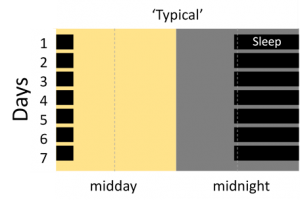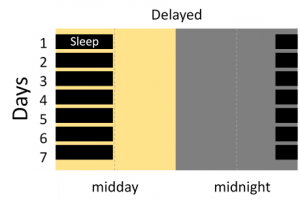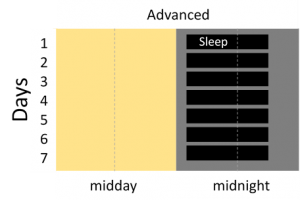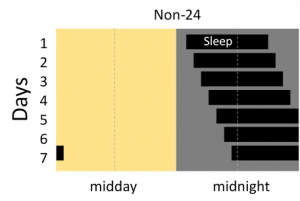General information
Circadian Rhythm Sleep-Wake Disorders (CRSDs) are sleep disorders in which the sleep-wake cycle is out of sync with the day-night cycle. Because of this mismatch between sleep timing and the external environment, people with a CRSD may experience an inability to sleep at certain times of the day and excessive sleepiness at other times of the day. This may impair their social life and performance at work or school. On this page, we'll explain the typical timing of sleep-wake cycles and describe the three most common CRSDs (Delayed Sleep Phase Disorder, Advanced Sleep Phase Disorder, and Non-24-Hour Sleep-Wake Disorder). For more information, visit the Circadian Sleep Disorders Network's website.
Typical sleep timing

Our sleep-wake cycles are driven by a homeostatic drive for sleep (sleep pressure) that builds up with increasing time spent awake and our internal circadian clock that generates periods of low and high sleep propensity across the 24-h day. For the majority of people, this results in a sleep-wake cycle of around 24 hours with sleep during the night – for example, from midnight until 8am. However, the timing of sleep onset and offset varies according to a person’s age and physiology: everyone has their own personalized sleep timing called a ‘chronotype’.
Delayed Sleep Phase Disorder (DSPD)

People with DSPD have a delayed onset of sleep. They are unable to fall asleep until very late at night or early morning, such as 3 or 4 am. This results in a need to sleep late into the morning or into the afternoon.
Advanced Sleep Phase Disorder (ASPD)

People with ASPD have an advanced onset of sleep. They tend to fall asleep very early in the evening or afternoon. As a result, they wake up very early in the morning, unable to sleep further.
Non-24-Hour Sleep-Wake Disorder (Non-24)

People with non-24 have a body clock that runs significantly longer than 24 hours. As a result,
sleep and wake times get later each day, drifting progressively around the clock.
